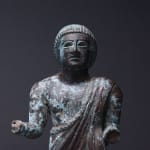Sabean Bronze Sculpture of a Standing Man, 6 Century BCE
Bronze
height 29.8 cm
height 11 3/4 in
height 11 3/4 in
X.0152
Further images
The ancient kingdom of Saba ruled over the lands of southern Arabia, centered in modern day Yemen. Saba is perhaps better known as Sheba, the Hebrew word for the kingdom,...
The ancient kingdom of Saba ruled over the lands of southern Arabia, centered in modern day Yemen. Saba is perhaps better known as Sheba, the Hebrew word for the kingdom, whose famous Queen was recounted as having visited Solomon in the pages of the Old Testament. Biblical accounts speak of the wealth of this ancient civilization of traders and merchants, and modern archaeological excavations confirm these reports. Ruins of fortresses and walled towns are evident and remnants of their extensive irrigation system that turned the desert into a paradise still cover the land. Although gold and silver deposits were present, the chief source of their vast wealth was derived from their veritable monopoly of two of the most coveted materials in ancient times: frankincense and myrrh, resinous gums obtained from certain trees that only grow in Southern Arabia and were literally worth their weight in gold. Perhaps their greatest accomplishment was the Great Dam of Marib, a monumental construction that brought water from the mountains both to the city and to the crop fields. The dam was in continual use (accounting for timely repairs) until the 6th Century A.D. and its ultimate destruction is detailed in the Koran as the end of the old world and a turning point in history. However, the civilization that created this wonder fell apart long before the damn did.
This impressive bronze sculpture of a standing man is a testament both to the wealth and the artistry of the Sabeans. Bronze was a precious material in these days and this substantial sculpture would have been worth a small fortune. This fact alone suggest that this work would have been commissioned either by a wealthy individual of the Sabean upper classes or, more likely, by a prosperous religious institution. Certain stylistic features, specifically the corkscrew rows of hair and the bodily proportions, are comparable to similar works dating from the 6th Century B.C. Other details, such as the stern facial features, rigid stance, and the stylized fold of the himation parallel aesthetic developments in Archaic Greek and Cypriot art, revealing that these cultures, while they were all linked by trade, also exchanged artistic ideas. This sculpture most likely represents a priest performing a ritual offering, notice the hilt of the knife tucked into his himation just below his large nipple. Might this work depict a priest about to undertake a ceremonial sacrifice honoring the gods? Perhaps this work stood inside an ancient temple where the bronze priest performed his sacrifice for all eternity.
This impressive bronze sculpture of a standing man is a testament both to the wealth and the artistry of the Sabeans. Bronze was a precious material in these days and this substantial sculpture would have been worth a small fortune. This fact alone suggest that this work would have been commissioned either by a wealthy individual of the Sabean upper classes or, more likely, by a prosperous religious institution. Certain stylistic features, specifically the corkscrew rows of hair and the bodily proportions, are comparable to similar works dating from the 6th Century B.C. Other details, such as the stern facial features, rigid stance, and the stylized fold of the himation parallel aesthetic developments in Archaic Greek and Cypriot art, revealing that these cultures, while they were all linked by trade, also exchanged artistic ideas. This sculpture most likely represents a priest performing a ritual offering, notice the hilt of the knife tucked into his himation just below his large nipple. Might this work depict a priest about to undertake a ceremonial sacrifice honoring the gods? Perhaps this work stood inside an ancient temple where the bronze priest performed his sacrifice for all eternity.









